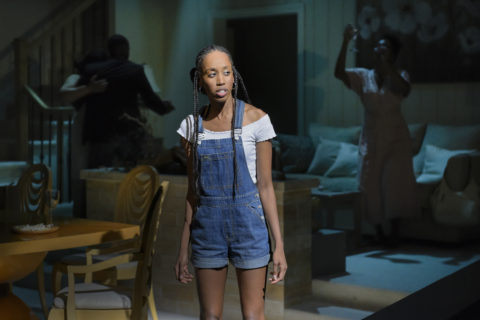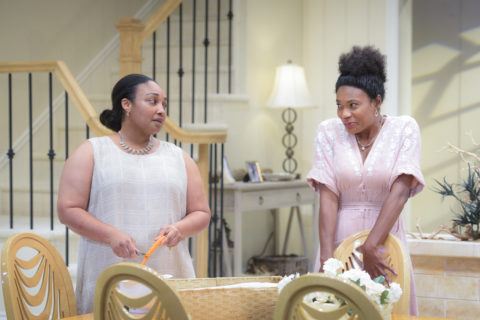
Monique Robinson plays Keisha (Photo: Kevin Berne/Berkeley Rep)
“Fairview,” Jackie Sibblies Drury’s exquisitely constructed drama, now at Berkeley Rep, requires concentrated observation. Its subject is a pernicious strain of unconcentrated observation—the casually de facto manner in which most Americans perceive race.
On entering the theater, audience members are immediately alerted to the fact that something unconventional is afoot: There’s a realistic middle-class living room/dining room set, but it’s framed by thick black walls, as if contained within a vitrine.
Sly and the Family Stone’s “Family Affair” fills the auditorium as audience members sway shoulders and bob heads in time to the music. Then the audio source relocates, and the song is isolated within the enclosed domestic diorama, soon populated by members of the Frasier family, gathering to celebrate a grandmother’s birthday: Mother Beverly (Natalie Venetia Belcon), father Dayton (Charles Browning), visiting Aunt Jasmine (Chantal Jean-Pierre) and teenage daughter Keisha (Monique Robinson, who brilliantly caspers her way through the fourth wall in “Fairview”’s scalding final moments).
The Frasiers are African-American. The audience knows this not because of anything its members do or say in their slightly sit-commy scenes of minor marital discord, sibling rivalry, adolescent self-absorption and other elements of suburban status quo. The audience knows the family is African American strictly because of their skin tones.
Well, also because of their musical taste. But, wait. Didn’t the white members of the audience share that musical taste just a few minutes prior? Shoulder sway, head bob…perspective shift. Drury subtly points out how quickly we choose to focus on counterpoint rather than harmony.
There’s a halt in the family scene. The Frasiers leave the set. As a pair of technicians make slight rearrangements of props and furniture to return the domestic scene to its starting point, four amplified voices—two male, two female—fill the auditorium. Intended as surrogates for white audience members’ conscious and/or subconscious thoughts, they’ve been watching the fishbowl action, too. Now, in the break, they’re musing about race, discussing what they’d choose to be if they weren’t white.
It’s an ugly conversation, full of reductive, stereotypical assumptions about Asian-American, Latinx and African-American personality traits, some blatantly racist, others self-serving perversions of P.C.

Natalie Venetia Belcon as Beverly and Chantal Jean-Pierre as Jasmine. (Photo: Kevin Berne/Berkeley Rep)
The poisonous thoughts here are nothing that audience members haven’t heard before. But Sibblies provokes us to consider not just the content of these thoughts, but what prompted them. Why is this conversation taking place at all?
The Frasier family scenes would have been equally as credible on “Growing Pains” as on “The Cosby Show” (Though “credible” may not be the right word to describe any sit-com).
It’s the mere observance of brown skin-tones that triggers our four interlocutors to reflexively summon up an entire nation carved into “us” and “them.”
The Frasiers return to the stage as this conversation continues and—in a stunning collaboration by the actors, choreographer Raja Feather Kelly, and director Sarah Benson—they play through the exact same actions we’ve seen before, but mouthing their dialogue in complete silence. Only the white observers’ ongoing conversation is audible now. The black characters’ benign lives are completely muted, and overlaid with amplified white presumption.
Two further movements within Drury’s intermissionless 90-minute piece—a detailed description would detract from their initially disconcerting, then luminously clarifying live experience—find the playwright extending her argument about the damage done when people, by dint of pigment alone, are subjected to ceaseless scrutiny, forced to perform in a constant spotlight and incessantly talked over rather than being allowed to speak for themselves.
The contributions of Mimi Lien’s set, Amith Chandrashaker’s lighting and Mikaal Sulaiman’s sound design to the nuance and impact of this production cannot be understated. Their blend of artistry and technical precision is revelatory. To appreciate it, though—as with all of “Fairview”—you must sit still, mute your own inner voices and observe keenly. Attention is due.
Originally published in the Bay Area Reporter
